Clinical Governance and Patient Care
VerifiedAdded on 2020/04/01
|9
|2068
|36
AI Summary
This assignment examines the crucial role of clinical governance in ensuring high-quality patient care. It analyzes a case study involving Mrs. Kimbo, highlighting missed opportunities for effective communication and patient understanding. The assignment emphasizes the significance of transparency, information sharing, and patient-centered approaches within clinical settings. It draws on relevant literature and professional guidelines to discuss best practices in clinical governance and its impact on patient safety and well-being.
Contribute Materials
Your contribution can guide someone’s learning journey. Share your
documents today.
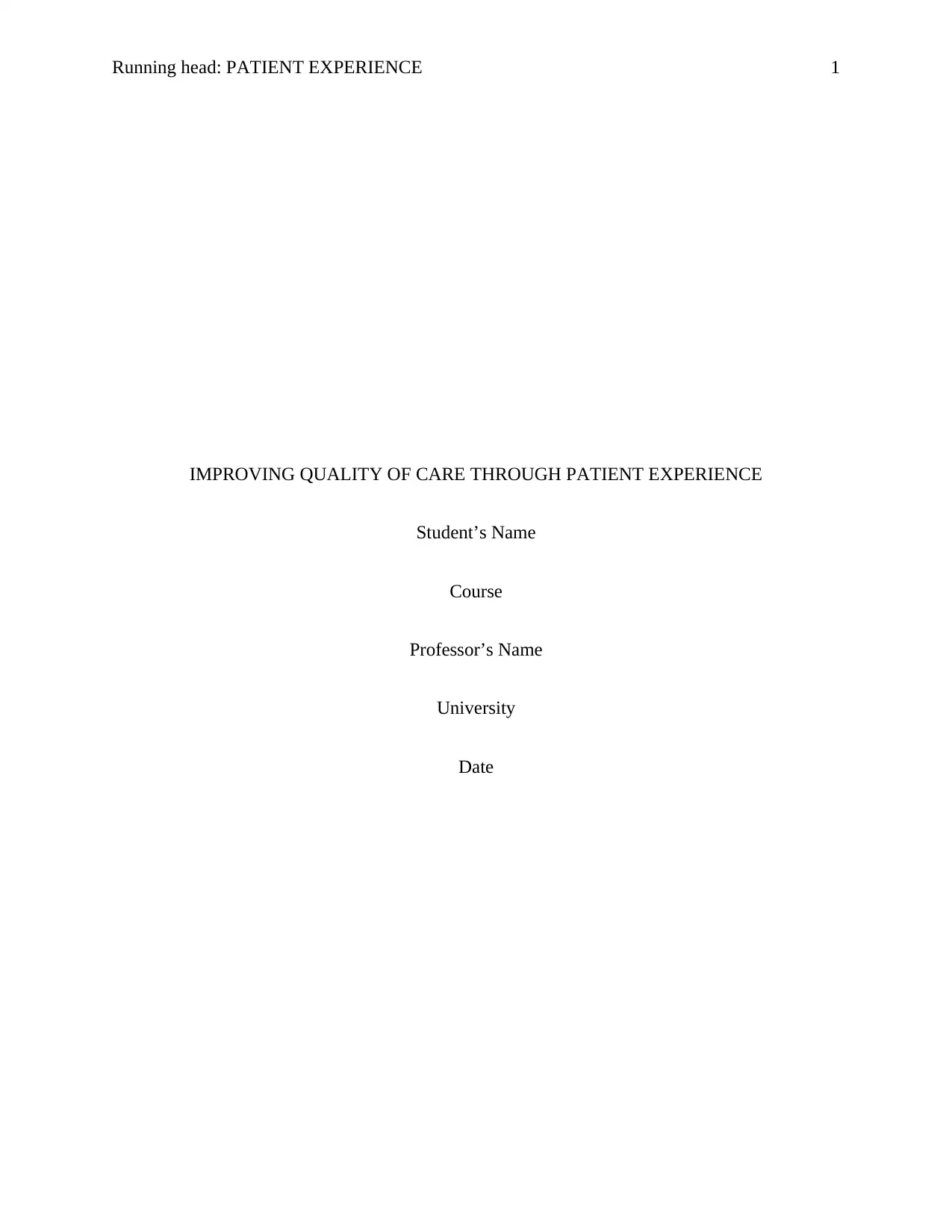
Running head: PATIENT EXPERIENCE 1
IMPROVING QUALITY OF CARE THROUGH PATIENT EXPERIENCE
Student’s Name
Course
Professor’s Name
University
Date
IMPROVING QUALITY OF CARE THROUGH PATIENT EXPERIENCE
Student’s Name
Course
Professor’s Name
University
Date
Secure Best Marks with AI Grader
Need help grading? Try our AI Grader for instant feedback on your assignments.
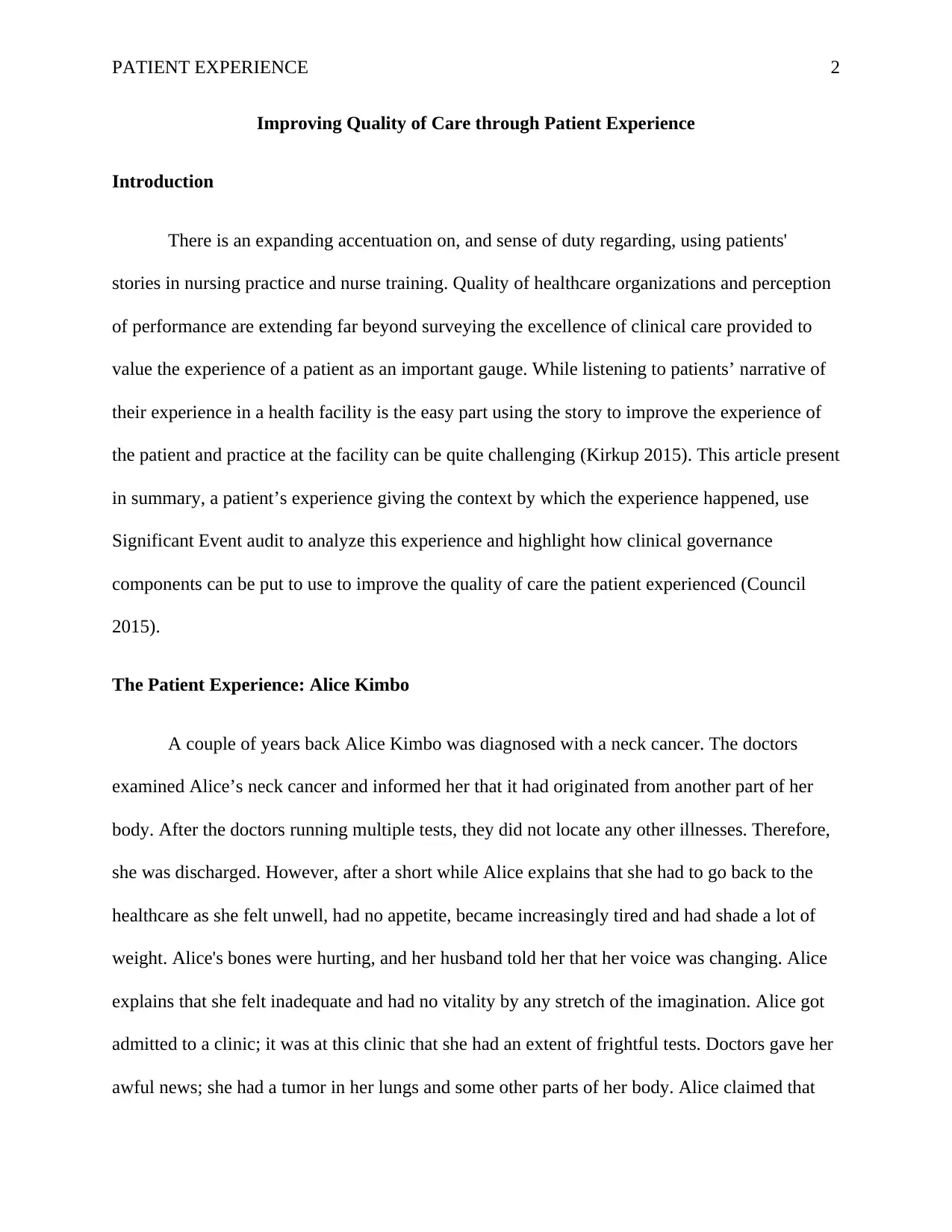
PATIENT EXPERIENCE 2
Improving Quality of Care through Patient Experience
Introduction
There is an expanding accentuation on, and sense of duty regarding, using patients'
stories in nursing practice and nurse training. Quality of healthcare organizations and perception
of performance are extending far beyond surveying the excellence of clinical care provided to
value the experience of a patient as an important gauge. While listening to patients’ narrative of
their experience in a health facility is the easy part using the story to improve the experience of
the patient and practice at the facility can be quite challenging (Kirkup 2015). This article present
in summary, a patient’s experience giving the context by which the experience happened, use
Significant Event audit to analyze this experience and highlight how clinical governance
components can be put to use to improve the quality of care the patient experienced (Council
2015).
The Patient Experience: Alice Kimbo
A couple of years back Alice Kimbo was diagnosed with a neck cancer. The doctors
examined Alice’s neck cancer and informed her that it had originated from another part of her
body. After the doctors running multiple tests, they did not locate any other illnesses. Therefore,
she was discharged. However, after a short while Alice explains that she had to go back to the
healthcare as she felt unwell, had no appetite, became increasingly tired and had shade a lot of
weight. Alice's bones were hurting, and her husband told her that her voice was changing. Alice
explains that she felt inadequate and had no vitality by any stretch of the imagination. Alice got
admitted to a clinic; it was at this clinic that she had an extent of frightful tests. Doctors gave her
awful news; she had a tumor in her lungs and some other parts of her body. Alice claimed that
Improving Quality of Care through Patient Experience
Introduction
There is an expanding accentuation on, and sense of duty regarding, using patients'
stories in nursing practice and nurse training. Quality of healthcare organizations and perception
of performance are extending far beyond surveying the excellence of clinical care provided to
value the experience of a patient as an important gauge. While listening to patients’ narrative of
their experience in a health facility is the easy part using the story to improve the experience of
the patient and practice at the facility can be quite challenging (Kirkup 2015). This article present
in summary, a patient’s experience giving the context by which the experience happened, use
Significant Event audit to analyze this experience and highlight how clinical governance
components can be put to use to improve the quality of care the patient experienced (Council
2015).
The Patient Experience: Alice Kimbo
A couple of years back Alice Kimbo was diagnosed with a neck cancer. The doctors
examined Alice’s neck cancer and informed her that it had originated from another part of her
body. After the doctors running multiple tests, they did not locate any other illnesses. Therefore,
she was discharged. However, after a short while Alice explains that she had to go back to the
healthcare as she felt unwell, had no appetite, became increasingly tired and had shade a lot of
weight. Alice's bones were hurting, and her husband told her that her voice was changing. Alice
explains that she felt inadequate and had no vitality by any stretch of the imagination. Alice got
admitted to a clinic; it was at this clinic that she had an extent of frightful tests. Doctors gave her
awful news; she had a tumor in her lungs and some other parts of her body. Alice claimed that
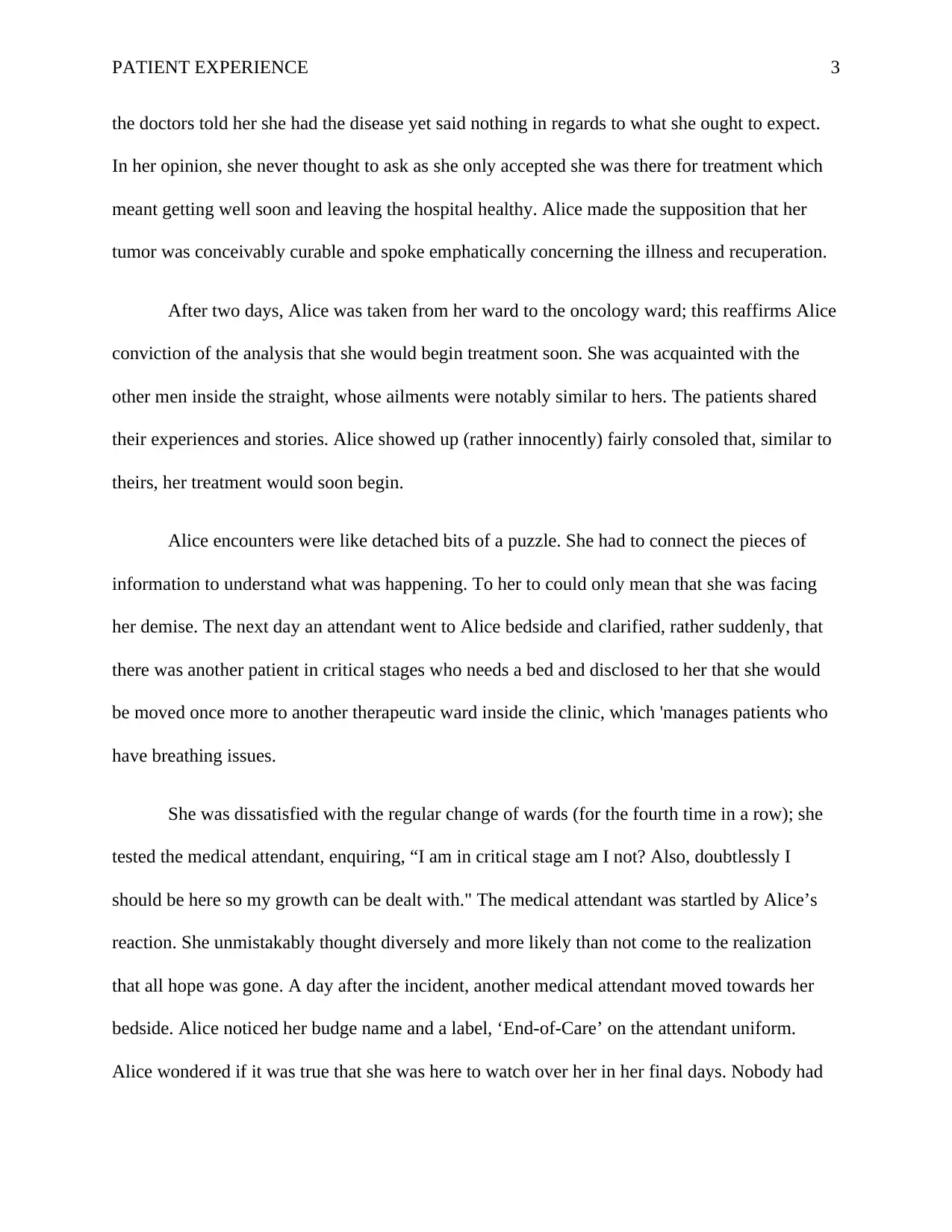
PATIENT EXPERIENCE 3
the doctors told her she had the disease yet said nothing in regards to what she ought to expect.
In her opinion, she never thought to ask as she only accepted she was there for treatment which
meant getting well soon and leaving the hospital healthy. Alice made the supposition that her
tumor was conceivably curable and spoke emphatically concerning the illness and recuperation.
After two days, Alice was taken from her ward to the oncology ward; this reaffirms Alice
conviction of the analysis that she would begin treatment soon. She was acquainted with the
other men inside the straight, whose ailments were notably similar to hers. The patients shared
their experiences and stories. Alice showed up (rather innocently) fairly consoled that, similar to
theirs, her treatment would soon begin.
Alice encounters were like detached bits of a puzzle. She had to connect the pieces of
information to understand what was happening. To her to could only mean that she was facing
her demise. The next day an attendant went to Alice bedside and clarified, rather suddenly, that
there was another patient in critical stages who needs a bed and disclosed to her that she would
be moved once more to another therapeutic ward inside the clinic, which 'manages patients who
have breathing issues.
She was dissatisfied with the regular change of wards (for the fourth time in a row); she
tested the medical attendant, enquiring, “I am in critical stage am I not? Also, doubtlessly I
should be here so my growth can be dealt with." The medical attendant was startled by Alice’s
reaction. She unmistakably thought diversely and more likely than not come to the realization
that all hope was gone. A day after the incident, another medical attendant moved towards her
bedside. Alice noticed her budge name and a label, ‘End-of-Care’ on the attendant uniform.
Alice wondered if it was true that she was here to watch over her in her final days. Nobody had
the doctors told her she had the disease yet said nothing in regards to what she ought to expect.
In her opinion, she never thought to ask as she only accepted she was there for treatment which
meant getting well soon and leaving the hospital healthy. Alice made the supposition that her
tumor was conceivably curable and spoke emphatically concerning the illness and recuperation.
After two days, Alice was taken from her ward to the oncology ward; this reaffirms Alice
conviction of the analysis that she would begin treatment soon. She was acquainted with the
other men inside the straight, whose ailments were notably similar to hers. The patients shared
their experiences and stories. Alice showed up (rather innocently) fairly consoled that, similar to
theirs, her treatment would soon begin.
Alice encounters were like detached bits of a puzzle. She had to connect the pieces of
information to understand what was happening. To her to could only mean that she was facing
her demise. The next day an attendant went to Alice bedside and clarified, rather suddenly, that
there was another patient in critical stages who needs a bed and disclosed to her that she would
be moved once more to another therapeutic ward inside the clinic, which 'manages patients who
have breathing issues.
She was dissatisfied with the regular change of wards (for the fourth time in a row); she
tested the medical attendant, enquiring, “I am in critical stage am I not? Also, doubtlessly I
should be here so my growth can be dealt with." The medical attendant was startled by Alice’s
reaction. She unmistakably thought diversely and more likely than not come to the realization
that all hope was gone. A day after the incident, another medical attendant moved towards her
bedside. Alice noticed her budge name and a label, ‘End-of-Care’ on the attendant uniform.
Alice wondered if it was true that she was here to watch over her in her final days. Nobody had
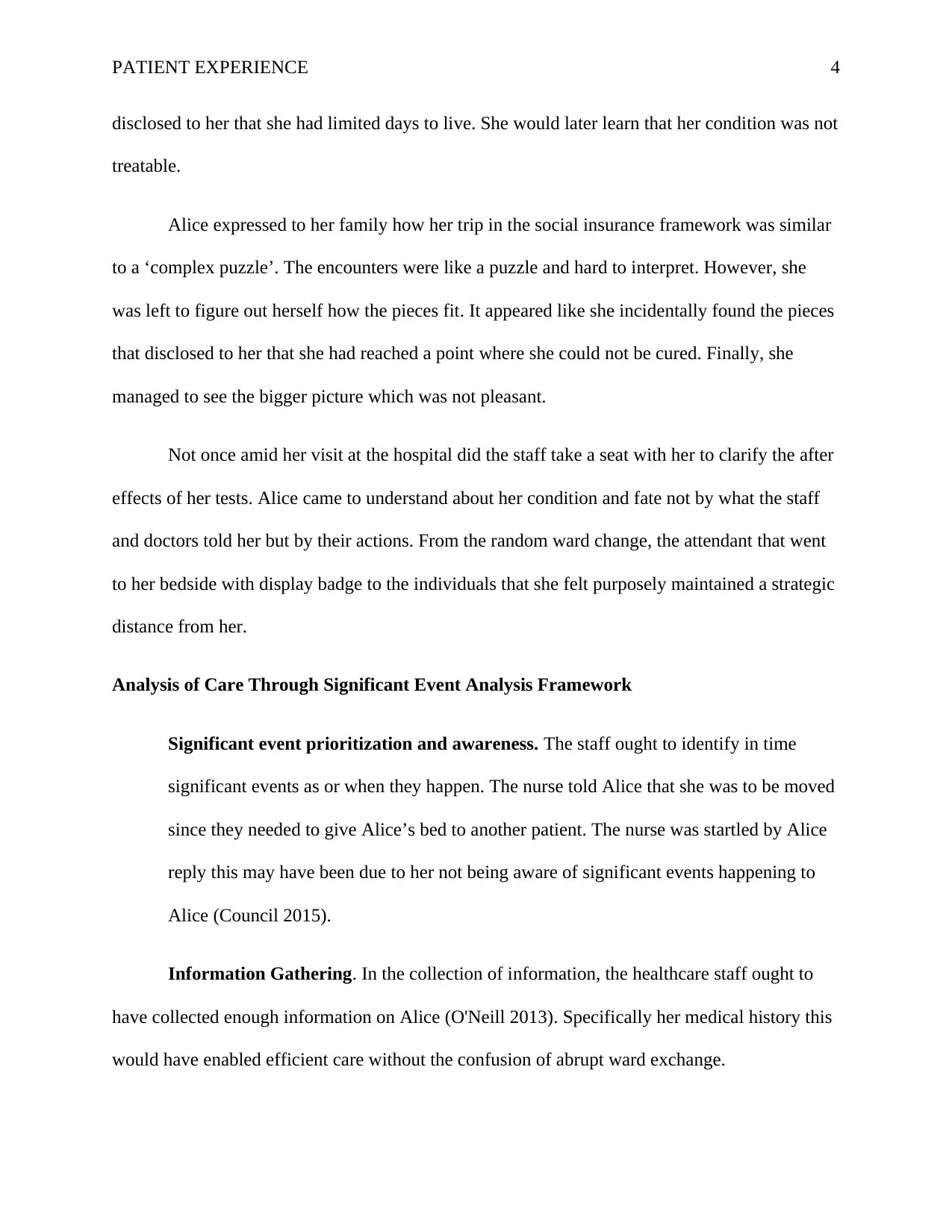
PATIENT EXPERIENCE 4
disclosed to her that she had limited days to live. She would later learn that her condition was not
treatable.
Alice expressed to her family how her trip in the social insurance framework was similar
to a ‘complex puzzle’. The encounters were like a puzzle and hard to interpret. However, she
was left to figure out herself how the pieces fit. It appeared like she incidentally found the pieces
that disclosed to her that she had reached a point where she could not be cured. Finally, she
managed to see the bigger picture which was not pleasant.
Not once amid her visit at the hospital did the staff take a seat with her to clarify the after
effects of her tests. Alice came to understand about her condition and fate not by what the staff
and doctors told her but by their actions. From the random ward change, the attendant that went
to her bedside with display badge to the individuals that she felt purposely maintained a strategic
distance from her.
Analysis of Care Through Significant Event Analysis Framework
Significant event prioritization and awareness. The staff ought to identify in time
significant events as or when they happen. The nurse told Alice that she was to be moved
since they needed to give Alice’s bed to another patient. The nurse was startled by Alice
reply this may have been due to her not being aware of significant events happening to
Alice (Council 2015).
Information Gathering. In the collection of information, the healthcare staff ought to
have collected enough information on Alice (O'Neill 2013). Specifically her medical history this
would have enabled efficient care without the confusion of abrupt ward exchange.
disclosed to her that she had limited days to live. She would later learn that her condition was not
treatable.
Alice expressed to her family how her trip in the social insurance framework was similar
to a ‘complex puzzle’. The encounters were like a puzzle and hard to interpret. However, she
was left to figure out herself how the pieces fit. It appeared like she incidentally found the pieces
that disclosed to her that she had reached a point where she could not be cured. Finally, she
managed to see the bigger picture which was not pleasant.
Not once amid her visit at the hospital did the staff take a seat with her to clarify the after
effects of her tests. Alice came to understand about her condition and fate not by what the staff
and doctors told her but by their actions. From the random ward change, the attendant that went
to her bedside with display badge to the individuals that she felt purposely maintained a strategic
distance from her.
Analysis of Care Through Significant Event Analysis Framework
Significant event prioritization and awareness. The staff ought to identify in time
significant events as or when they happen. The nurse told Alice that she was to be moved
since they needed to give Alice’s bed to another patient. The nurse was startled by Alice
reply this may have been due to her not being aware of significant events happening to
Alice (Council 2015).
Information Gathering. In the collection of information, the healthcare staff ought to
have collected enough information on Alice (O'Neill 2013). Specifically her medical history this
would have enabled efficient care without the confusion of abrupt ward exchange.
Secure Best Marks with AI Grader
Need help grading? Try our AI Grader for instant feedback on your assignments.
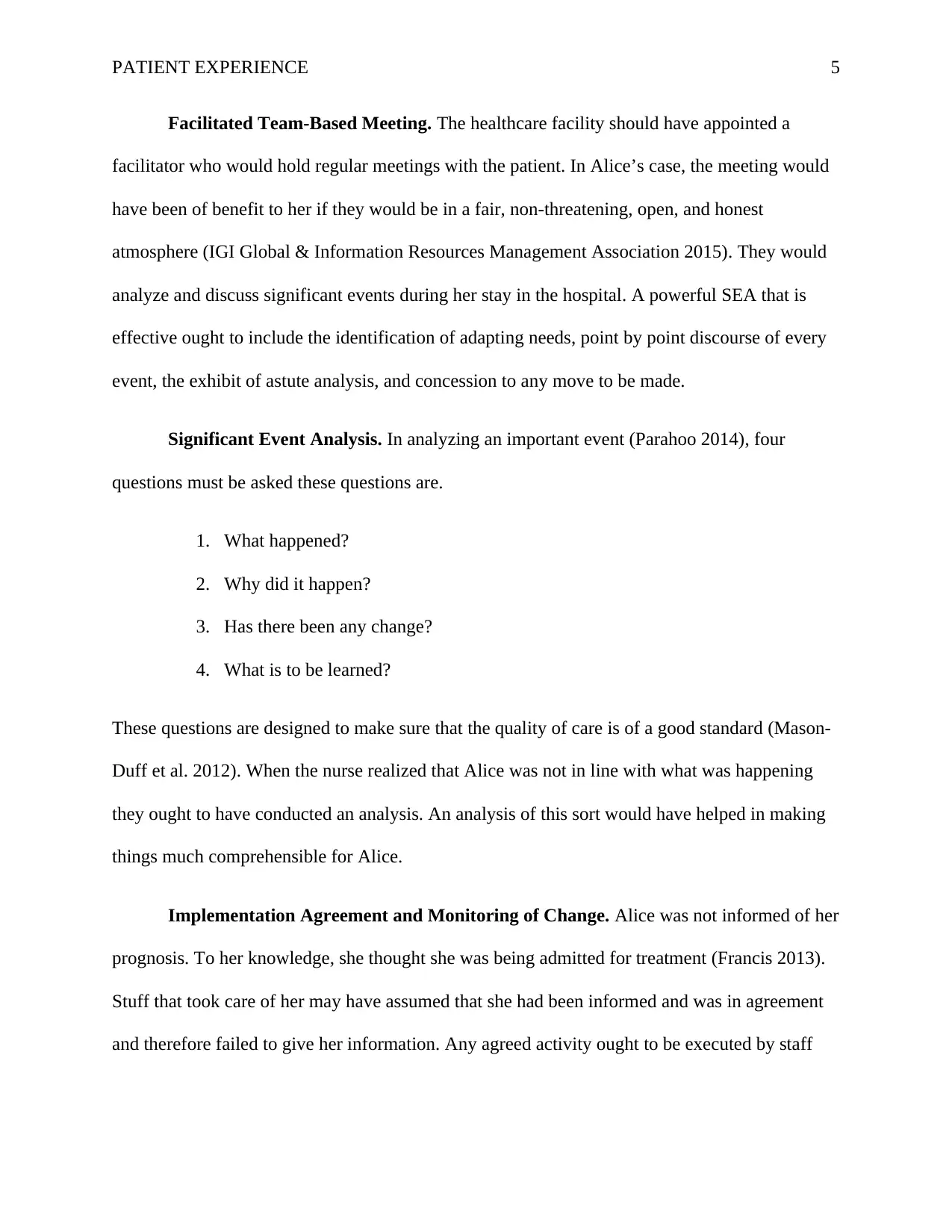
PATIENT EXPERIENCE 5
Facilitated Team-Based Meeting. The healthcare facility should have appointed a
facilitator who would hold regular meetings with the patient. In Alice’s case, the meeting would
have been of benefit to her if they would be in a fair, non-threatening, open, and honest
atmosphere (IGI Global & Information Resources Management Association 2015). They would
analyze and discuss significant events during her stay in the hospital. A powerful SEA that is
effective ought to include the identification of adapting needs, point by point discourse of every
event, the exhibit of astute analysis, and concession to any move to be made.
Significant Event Analysis. In analyzing an important event (Parahoo 2014), four
questions must be asked these questions are.
1. What happened?
2. Why did it happen?
3. Has there been any change?
4. What is to be learned?
These questions are designed to make sure that the quality of care is of a good standard (Mason-
Duff et al. 2012). When the nurse realized that Alice was not in line with what was happening
they ought to have conducted an analysis. An analysis of this sort would have helped in making
things much comprehensible for Alice.
Implementation Agreement and Monitoring of Change. Alice was not informed of her
prognosis. To her knowledge, she thought she was being admitted for treatment (Francis 2013).
Stuff that took care of her may have assumed that she had been informed and was in agreement
and therefore failed to give her information. Any agreed activity ought to be executed by staff
Facilitated Team-Based Meeting. The healthcare facility should have appointed a
facilitator who would hold regular meetings with the patient. In Alice’s case, the meeting would
have been of benefit to her if they would be in a fair, non-threatening, open, and honest
atmosphere (IGI Global & Information Resources Management Association 2015). They would
analyze and discuss significant events during her stay in the hospital. A powerful SEA that is
effective ought to include the identification of adapting needs, point by point discourse of every
event, the exhibit of astute analysis, and concession to any move to be made.
Significant Event Analysis. In analyzing an important event (Parahoo 2014), four
questions must be asked these questions are.
1. What happened?
2. Why did it happen?
3. Has there been any change?
4. What is to be learned?
These questions are designed to make sure that the quality of care is of a good standard (Mason-
Duff et al. 2012). When the nurse realized that Alice was not in line with what was happening
they ought to have conducted an analysis. An analysis of this sort would have helped in making
things much comprehensible for Alice.
Implementation Agreement and Monitoring of Change. Alice was not informed of her
prognosis. To her knowledge, she thought she was being admitted for treatment (Francis 2013).
Stuff that took care of her may have assumed that she had been informed and was in agreement
and therefore failed to give her information. Any agreed activity ought to be executed by staff
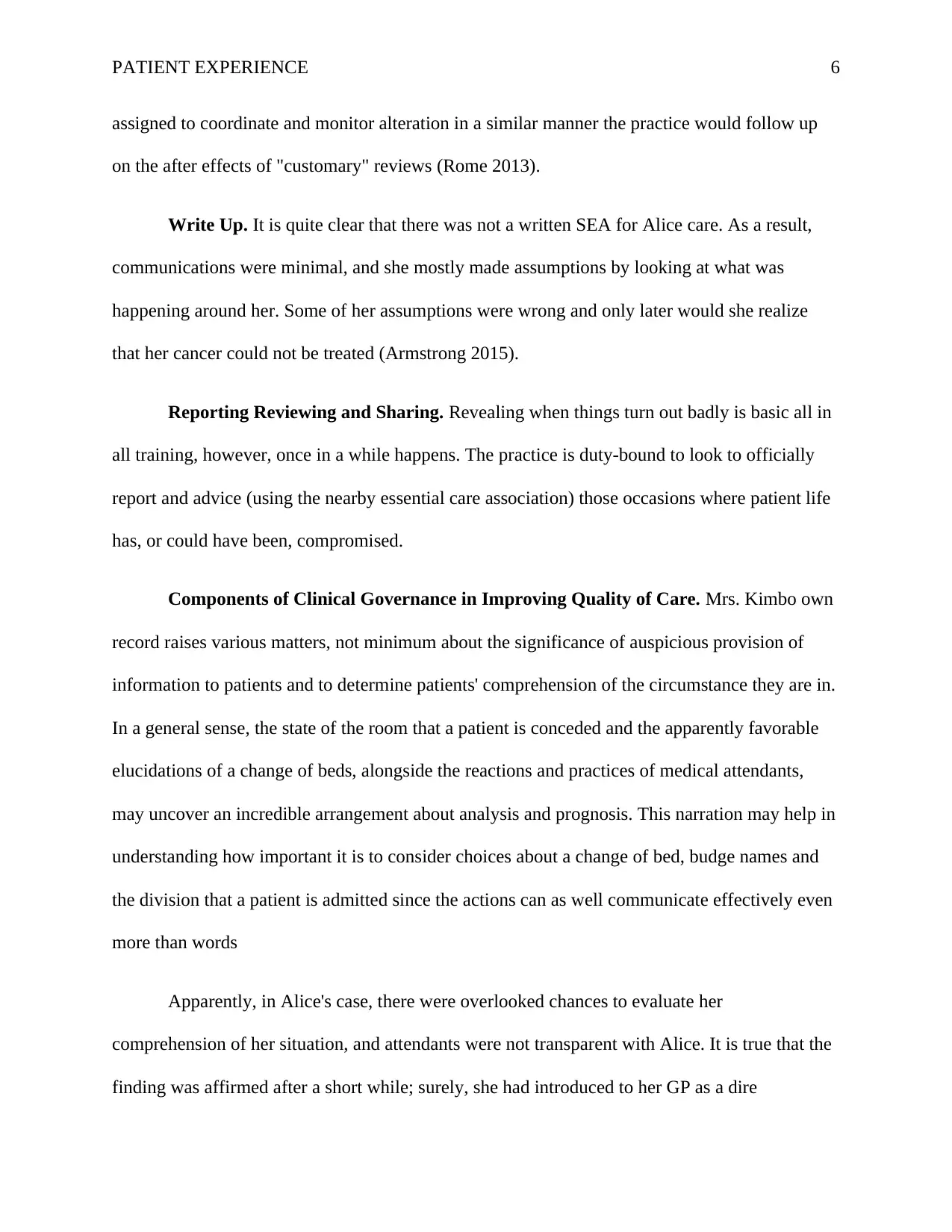
PATIENT EXPERIENCE 6
assigned to coordinate and monitor alteration in a similar manner the practice would follow up
on the after effects of "customary" reviews (Rome 2013).
Write Up. It is quite clear that there was not a written SEA for Alice care. As a result,
communications were minimal, and she mostly made assumptions by looking at what was
happening around her. Some of her assumptions were wrong and only later would she realize
that her cancer could not be treated (Armstrong 2015).
Reporting Reviewing and Sharing. Revealing when things turn out badly is basic all in
all training, however, once in a while happens. The practice is duty-bound to look to officially
report and advice (using the nearby essential care association) those occasions where patient life
has, or could have been, compromised.
Components of Clinical Governance in Improving Quality of Care. Mrs. Kimbo own
record raises various matters, not minimum about the significance of auspicious provision of
information to patients and to determine patients' comprehension of the circumstance they are in.
In a general sense, the state of the room that a patient is conceded and the apparently favorable
elucidations of a change of beds, alongside the reactions and practices of medical attendants,
may uncover an incredible arrangement about analysis and prognosis. This narration may help in
understanding how important it is to consider choices about a change of bed, budge names and
the division that a patient is admitted since the actions can as well communicate effectively even
more than words
Apparently, in Alice's case, there were overlooked chances to evaluate her
comprehension of her situation, and attendants were not transparent with Alice. It is true that the
finding was affirmed after a short while; surely, she had introduced to her GP as a dire
assigned to coordinate and monitor alteration in a similar manner the practice would follow up
on the after effects of "customary" reviews (Rome 2013).
Write Up. It is quite clear that there was not a written SEA for Alice care. As a result,
communications were minimal, and she mostly made assumptions by looking at what was
happening around her. Some of her assumptions were wrong and only later would she realize
that her cancer could not be treated (Armstrong 2015).
Reporting Reviewing and Sharing. Revealing when things turn out badly is basic all in
all training, however, once in a while happens. The practice is duty-bound to look to officially
report and advice (using the nearby essential care association) those occasions where patient life
has, or could have been, compromised.
Components of Clinical Governance in Improving Quality of Care. Mrs. Kimbo own
record raises various matters, not minimum about the significance of auspicious provision of
information to patients and to determine patients' comprehension of the circumstance they are in.
In a general sense, the state of the room that a patient is conceded and the apparently favorable
elucidations of a change of beds, alongside the reactions and practices of medical attendants,
may uncover an incredible arrangement about analysis and prognosis. This narration may help in
understanding how important it is to consider choices about a change of bed, budge names and
the division that a patient is admitted since the actions can as well communicate effectively even
more than words
Apparently, in Alice's case, there were overlooked chances to evaluate her
comprehension of her situation, and attendants were not transparent with Alice. It is true that the
finding was affirmed after a short while; surely, she had introduced to her GP as a dire
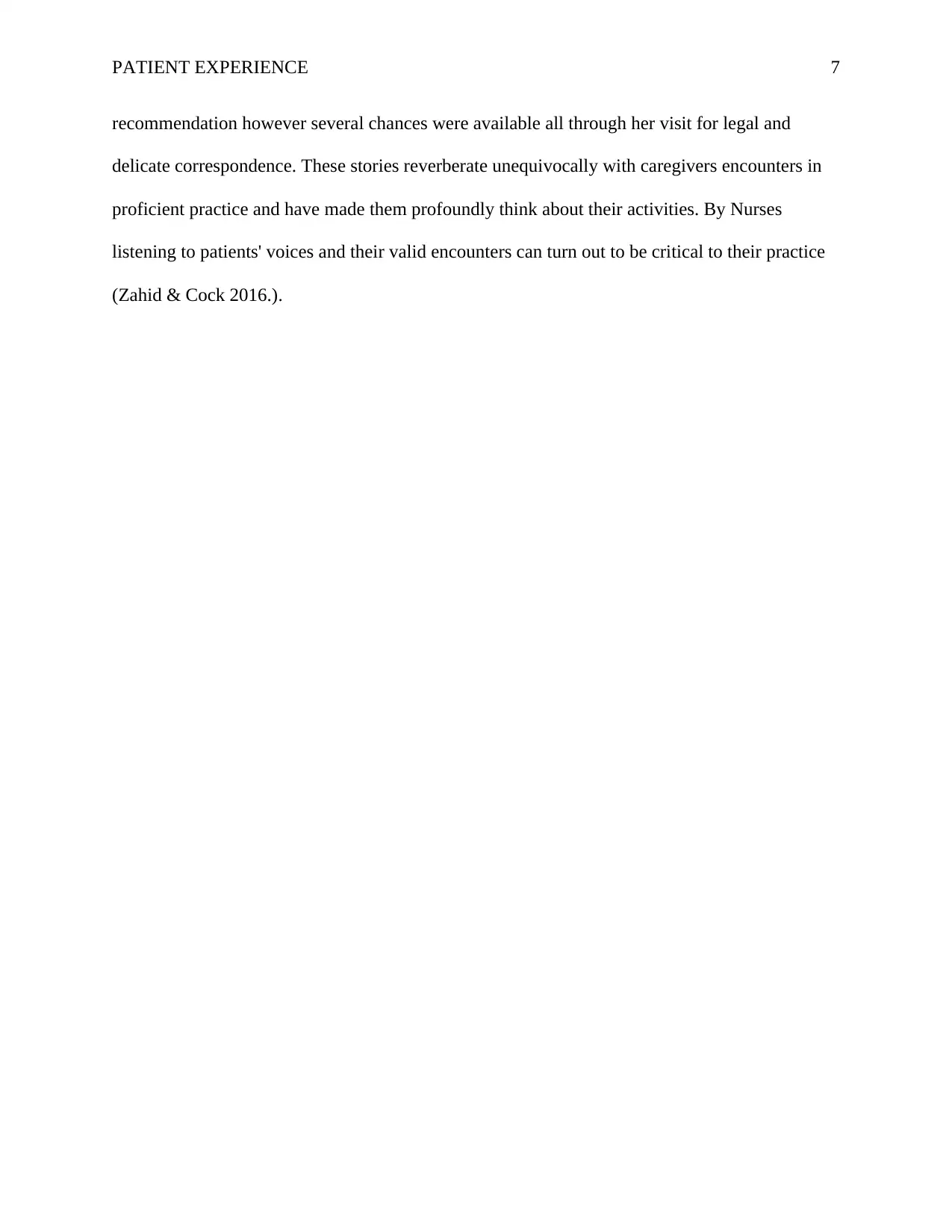
PATIENT EXPERIENCE 7
recommendation however several chances were available all through her visit for legal and
delicate correspondence. These stories reverberate unequivocally with caregivers encounters in
proficient practice and have made them profoundly think about their activities. By Nurses
listening to patients' voices and their valid encounters can turn out to be critical to their practice
(Zahid & Cock 2016.).
recommendation however several chances were available all through her visit for legal and
delicate correspondence. These stories reverberate unequivocally with caregivers encounters in
proficient practice and have made them profoundly think about their activities. By Nurses
listening to patients' voices and their valid encounters can turn out to be critical to their practice
(Zahid & Cock 2016.).
Paraphrase This Document
Need a fresh take? Get an instant paraphrase of this document with our AI Paraphraser
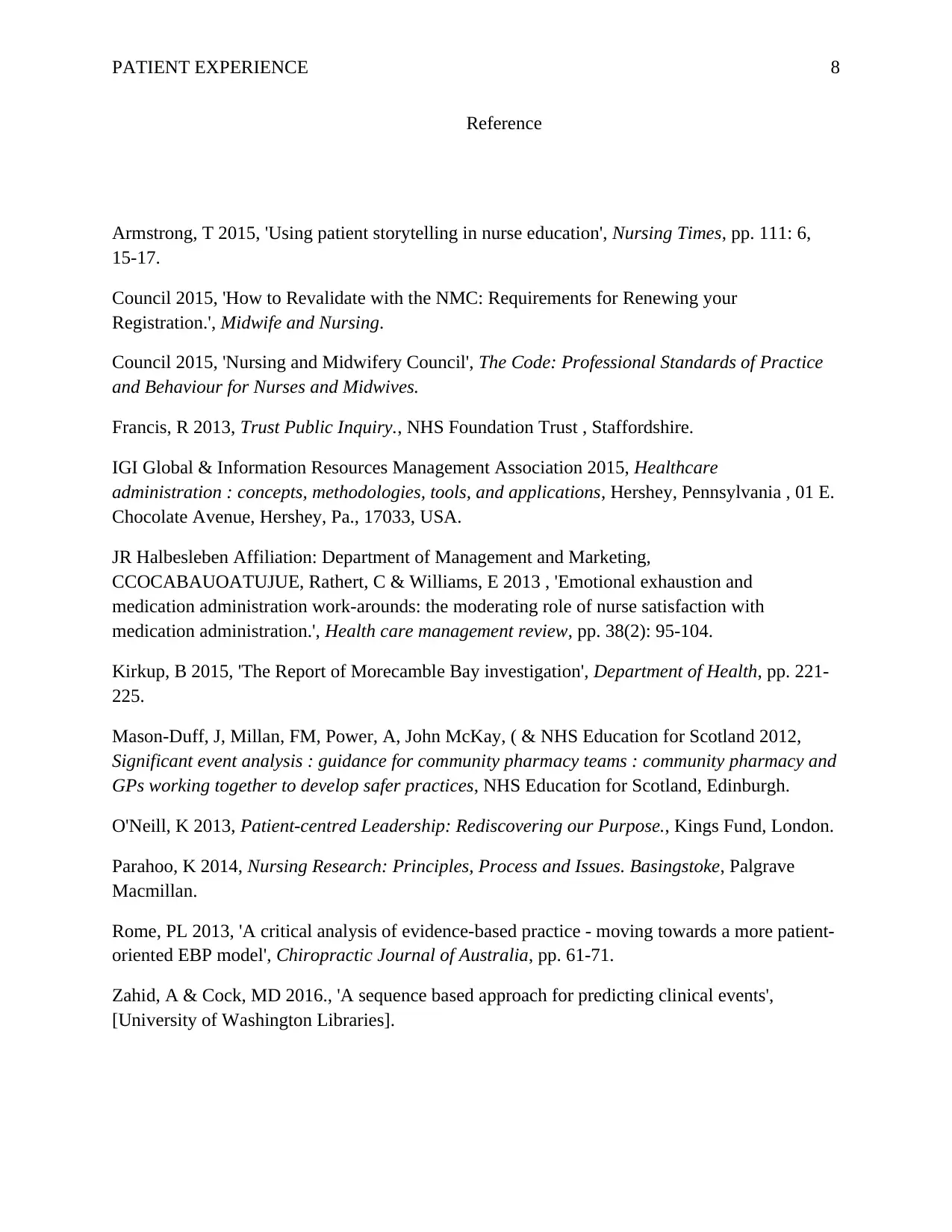
PATIENT EXPERIENCE 8
Reference
Armstrong, T 2015, 'Using patient storytelling in nurse education', Nursing Times, pp. 111: 6,
15-17.
Council 2015, 'How to Revalidate with the NMC: Requirements for Renewing your
Registration.', Midwife and Nursing.
Council 2015, 'Nursing and Midwifery Council', The Code: Professional Standards of Practice
and Behaviour for Nurses and Midwives.
Francis, R 2013, Trust Public Inquiry., NHS Foundation Trust , Staffordshire.
IGI Global & Information Resources Management Association 2015, Healthcare
administration : concepts, methodologies, tools, and applications, Hershey, Pennsylvania , 01 E.
Chocolate Avenue, Hershey, Pa., 17033, USA.
JR Halbesleben Affiliation: Department of Management and Marketing,
CCOCABAUOATUJUE, Rathert, C & Williams, E 2013 , 'Emotional exhaustion and
medication administration work-arounds: the moderating role of nurse satisfaction with
medication administration.', Health care management review, pp. 38(2): 95-104.
Kirkup, B 2015, 'The Report of Morecamble Bay investigation', Department of Health, pp. 221-
225.
Mason-Duff, J, Millan, FM, Power, A, John McKay, ( & NHS Education for Scotland 2012,
Significant event analysis : guidance for community pharmacy teams : community pharmacy and
GPs working together to develop safer practices, NHS Education for Scotland, Edinburgh.
O'Neill, K 2013, Patient-centred Leadership: Rediscovering our Purpose., Kings Fund, London.
Parahoo, K 2014, Nursing Research: Principles, Process and Issues. Basingstoke, Palgrave
Macmillan.
Rome, PL 2013, 'A critical analysis of evidence-based practice - moving towards a more patient-
oriented EBP model', Chiropractic Journal of Australia, pp. 61-71.
Zahid, A & Cock, MD 2016., 'A sequence based approach for predicting clinical events',
[University of Washington Libraries].
Reference
Armstrong, T 2015, 'Using patient storytelling in nurse education', Nursing Times, pp. 111: 6,
15-17.
Council 2015, 'How to Revalidate with the NMC: Requirements for Renewing your
Registration.', Midwife and Nursing.
Council 2015, 'Nursing and Midwifery Council', The Code: Professional Standards of Practice
and Behaviour for Nurses and Midwives.
Francis, R 2013, Trust Public Inquiry., NHS Foundation Trust , Staffordshire.
IGI Global & Information Resources Management Association 2015, Healthcare
administration : concepts, methodologies, tools, and applications, Hershey, Pennsylvania , 01 E.
Chocolate Avenue, Hershey, Pa., 17033, USA.
JR Halbesleben Affiliation: Department of Management and Marketing,
CCOCABAUOATUJUE, Rathert, C & Williams, E 2013 , 'Emotional exhaustion and
medication administration work-arounds: the moderating role of nurse satisfaction with
medication administration.', Health care management review, pp. 38(2): 95-104.
Kirkup, B 2015, 'The Report of Morecamble Bay investigation', Department of Health, pp. 221-
225.
Mason-Duff, J, Millan, FM, Power, A, John McKay, ( & NHS Education for Scotland 2012,
Significant event analysis : guidance for community pharmacy teams : community pharmacy and
GPs working together to develop safer practices, NHS Education for Scotland, Edinburgh.
O'Neill, K 2013, Patient-centred Leadership: Rediscovering our Purpose., Kings Fund, London.
Parahoo, K 2014, Nursing Research: Principles, Process and Issues. Basingstoke, Palgrave
Macmillan.
Rome, PL 2013, 'A critical analysis of evidence-based practice - moving towards a more patient-
oriented EBP model', Chiropractic Journal of Australia, pp. 61-71.
Zahid, A & Cock, MD 2016., 'A sequence based approach for predicting clinical events',
[University of Washington Libraries].

PATIENT EXPERIENCE 9
1 out of 9
Related Documents
Your All-in-One AI-Powered Toolkit for Academic Success.
+13062052269
info@desklib.com
Available 24*7 on WhatsApp / Email
![[object Object]](/_next/static/media/star-bottom.7253800d.svg)
Unlock your academic potential
© 2024 | Zucol Services PVT LTD | All rights reserved.





